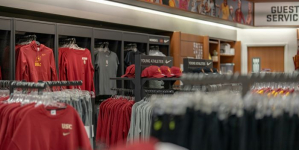-
AI startup Onton raises $7.5M to reinvent the way the world discovers and decides what to buy - November 26, 2025
-
Forklift Market Positions for Recovery as Confidence Expected to Build from 2026 - November 26, 2025
-
PROCare achieves 300% order capacity increase and 99% picking accuracy with Forterro’s ERP solution, Orderwise - November 26, 2025
-
DHL boosts operational efficiency and customer communications with HappyRobot’s AI Agents - November 25, 2025
-
STENA LINE TEAMS UP WITH CAMERA TELEMATICS TO DRIVE SAFETY IMPROVEMENTS AT IRISH SEA PORTS - November 25, 2025
-
Another design award for Toyota’s lithium-ion Traigo_i counterbalanced forklift - November 21, 2025
-
Stuut Technologies Raises $29.5 Million Series A Led by Andreessen Horowitz to Automate Accounts Receivable Work - November 20, 2025
-
INCREASED DIGITAL INVESTMENT REQUIRED TO KEEP PACE WITH 2026 CUSTOMS CHANGES - November 19, 2025
-
FULFILMENT SOLUTIONS FOR SPORTS MERCHANDISE: KEEPING OUR EYE ON THE GAME - November 19, 2025
-
COMPLEX, COSTLY & CONFUSING – THE END OF DE MINIMIS - November 19, 2025
How E-Commerce is Redefining North American Supply Chains.
By Greg West, VP of LTL at C.H. Robinson.
It’s hard to remember logistics in the United States before e-commerce began in earnest a decade ago. First, e-commerce disrupted the established ordering and delivery processes that were available through brick-and-mortar stores and catalog channels. Now, as e-commerce grows in Canada and Mexico, companies doing business throughout North America might need to rethink their current supply chain strategies for inventory, deliveries, and returns.
As this growth continues, related issues, such as the increase in reverse logistics requirements, are powering a “new normal” of disruptive reality that is leading companies to reconsider their existing practices. And as logistics strategy continues to evolve, it is becoming more difficult than ever to be predictive.
How supply chain requirements are changing
As recently as a decade ago, supply chain managers for brick-and-mortar retailers aimed to keep minimal inventories in their stores and warehouses. They built up their inventories during the autumn months to prepare for the holiday shopping season. This created an annual shipping peak for ports, railroads, and trucking companies, after which demand would subside significantly.
Thanks in part to e-commerce, today’s shipping patterns are no longer as predictable. That is because e-commerce has reshaped consumer habits and expectations throughout North America in two important ways. First, consumers, even those in remote areas, are accustomed to purchasing from home (or on the go), receiving their items quickly and enjoying free shipping. Second, returns are much more widely welcomed by e-commerce firms.
All of this has significant implications for North American supply chains. E-commerce encourages the consumer to order more frequently and in smaller batches. Shorr Packaging explored the effect of this change on ordering and shipping in October 2015, and found that brick-and-mortar stores had an average of 5.4 units per order line, while e-commerce’s average is 1.6 units per order line. Orders that used to ship by the pallet now move as single units, and the smaller orders ship more frequently than ever before.
With the growth of e-commerce in Canada, Mexico, and the United States, consumer expectations changed permanently. Consumers expect to buy and return freely — simple for them, but quite challenging for logisticians to accomplish in a cost-effective way. The Shorr Packaging report showed that 9 percent of goods ordered through brick-and-mortar stores required reverse logistics, while 30 percent of e-commerce products require returns.
Changing strategies for inventory, deliveries and returns
E-commerce demands ever-faster shifts to smaller, flexible facilities and more integrated reverse logistics programs. To respond to the growth in e-commerce, many retailers have increased their permanent downstream inventories in an effort to make their logistics (and reverse logistics) more responsive and robust. Some have also changed the way they manage their inventories, moving from mega-warehouses to smaller, more flexible facilities located closer to the consumer.
Blaine Kelley of CBRE, a commercial real estate firm, has noted a continual increase in net absorption (the industry metric for occupancy) of warehouse space for 24 consecutive quarters. Kelley says we are now at a 15-year high. As recently as 2014, absorption growth came from “big box” warehouses; today, the source is smaller facilities in densely populated urban areas. While this trend is being set by the e-commerce giants, smaller players are also beginning to invest.
As companies manage this transition, the leg of the supply chain journey that is becoming more and more critical is the “last mile” delivery—shipping from final storage point to the consumer. Having more distribution centers located near dense areas decreases the average shipping distance, which is great for consumers, but chips away at many of the efficiencies that transportation providers have gained over the years. Derek Leathers, president and chief operating officer of Werner Enterprises, a transportation and logistics company based in Nebraska, has seen truckload miles per truckload trip decrease 25 percent over the last few years—from 700 or 800 miles to 500.
Less than truckload (LTL) players are also seeing a dramatic effect. LTL is a $42 billion business that has grown at 9 percent annually since 2009, and the boom does not appear to be letting up. In large measure, e-commerce and growth in reverse logistics have boosted LTL, helping the industry stay resilient through the tough recent period for truckload companies. LTL companies have become increasingly efficient at moving freight out of their network and have been cautious about expansion. Relatively strong LTL performance is an indicator that those companies equipped to deliver faster, more tailored service to customers are best positioned in the new supply chain environment.
E-commerce growth in Canada and Mexico
The effect of e-commerce might have hit hardest and first in the United States, but it is having a growing impact on the country’s neighbors. In Canada, online retail sales are outpacing overall retail sales. Online retail consumer spending in 2014 was 22.3 billion Canadian dollars and is expected to grow to CA$39.9 billion in 2019, representing nearly 10 percent of total transactions by that time.
Although this is certainly behind the United States, a number of the obstacles that have held Canadian consumers back from e-commerce might be fading away. Infrastructure investment in Canada could lower the cost of shipping, which has been an obstacle to e-commerce growth in Canada. Additionally, big retailers have put in place a strong strategy, organization, and footprint to offer massive scale to Canadian consumers. Canadian consumers have many of the same tastes and desires as Americans and are expected to quickly grow as comfortable as Americans with the channel.
Mexico is also beginning to catch up in e-commerce. However, the difference here is that while transportation supply is affordable and plentiful, credit cards are far less prevalent, making it more difficult for consumers to transact. Despite that, online sales are expected to double (from 2 percent to 4 percent) by 2020. E-commerce sales will likely continue to grow quickly as payments become more streamlined; again, it is the large players who are driving the change. Amazon launched an end-to-end Mexican operation in June 2016 and is already making changes to provide access to their offerings at a massive scale — for example, by selling gift cards that can be bought with cash at stores all over the country. This, combined with excess (and easily scalable) carrier capacity, can be expected to drive fast growth in the coming decade.
What’s next?
Shippers and carriers are always re-evaluating their transportation strategies based on ever-changing economic, regulatory and political environments. The impact of e-commerce on companies in North America is simply the latest factor in this ongoing evolution.
Until recently, consumers were “takers” when it came to parcel delivery, having to accept whatever service levels companies provided unless they wanted to pay significantly extra to expedite. E-commerce has turned that idea on its head. The trend throughout North America is toward keeping inventory near consumers, accommodating smaller, faster deliveries, and having reverse logistics to handle more frequent returns.
Consumer preferences, enabled by ecommerce, have permanently shifted the supply chain landscape. As a result, companies are being forced to invest in a more agile set of distribution centers that seamlessly integrate forward and reverse logistics. This dynamic has buoyed demand for LTL providers of last-mile delivery. Companies that integrate transportation squarely into their corporate strategies can best differentiate themselves in the eyes of customers.
References: Peter T. Leach, “E-commerce growth squeezing tight industrial real estate market,” Journal of Commerce, April 3, 2016.
“E-commerce means ‘continuous change’ for shippers, transport operators,” Journal of Commerce, April 13, 2014.
United States Annual Census Survey, “Estimated Revenue by Tax Status for Employer Firms, 2007 Through 2014,” U.S. Census Bureau.
Forrester, “Canadian Online Retail Forecast, 2014-2019,” October 2014.
Ibid.
Anthony Harrup, “Mexican E-Commerce Grows, but Requires Some Coaxing,” Wall Street Journal, January 1, 2016.

































